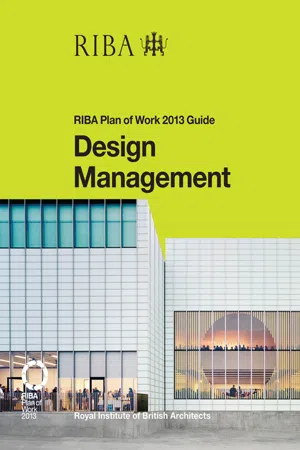
- 160 pages
- English
- ePUB (mobile friendly)
- Available on iOS & Android
About This Book
The RIBA Plan of Work 2013 Guide: Design Management is part of a brand new series providing must-read practical guidance to running efficient and successful projects using the new RIBA Plan of Work 2013. Each guide takes a core project task – in this case the role of the Design Lead - and explains the essential activities and considerations required at each stage of the new Plan of Work.
Easy to use and navigate and in a small and handy format these guides will provide the ultimate quick reference support at your desk or on site. The author provides concise and pragmatic advice rooted in real world experience – a 'how to' that will resonate with practitioners. In-text features such as 'hints and tips', 'checklists', 'forms and templates' and 'signposts' to trusted resources will provide user-friendly support. Boxed examples will highlight best practice and illuminate common problems and solutions borne of hard won experience.
Frequently asked questions
Information
Stage 1
Preparation and Brief

Chapter overview
Introduction
What are the Core Objectives of this stage?

What are the Project Objectives?
- Quality Objectives
Quality Objectives relate primarily to design quality and can cover a diverse range of subjects, such as finishes, products, or the quality of core spaces. When setting Quality Objectives, it is extremely helpful to visit exemplar projects with the client. This allows likes and dislikes to be determined, minimising the risk of the design team taking an approach that will not be supported by the client. In some instances an architect will be chosen because the client has seen and liked previous projects that they have undertaken. In these situations it may be less necessary to set Quality Objectives. - Project Outcomes
Project Outcomes are a crucial new inclusion in the RIBA Plan of Work 2013. While the Quality Objectives might focus on the building as an output, the Project Outcomes will consider the business or other In Use outcomes that the client may wish to achieve. Examples might include:- reduced reoffending rates for a new prison
- improved examination results for a new school
- shorter recovery times for a new hospital.
Why are the Sustainability Aspirations a crucial consideration within the brief?
- assessments to be undertaken and rating achieved (eg BREEAM Outstanding)
- energy targets including embodied energy and carbon
- the extent of community involvement and consultation.
What is the Project Budget and how might it influence the brief?
Table of contents
- Cover
- Half Title
- Series Page
- Title
- Copyright
- Contents
- Foreword
- Series editor’s foreword
- Acknowledgements and dedication
- About the author and series editor
- Introduction
- The RIBA Plan of Work 2013
- Stage 0 Strategic Definition
- Stage 1 Preparation and Brief
- Stage 2 Concept Design
- Stage 3 Developed Design
- Stage 4 Technical Design
- Stage 5 Construction
- Stage 6 Handover and Close Out
- Stage 7 In Use
- Design management glossary
- RIBA Plan of Work 2013 glossary
- Index